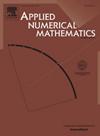Discretization methods and their extrapolations for two-dimensional nonlinear Volterra-Urysohn integral equations
IF 2.2
2区 数学
Q1 MATHEMATICS, APPLIED
引用次数: 0
Abstract
In this paper, a class of nonlinear two-dimensional (2D) integral equations of Volterra type, i.e. Volterra-Urysohn integral equations, is studied. Following the ideas of [24], and assuming that the kernels of the integral equation are Lipschitz functions with respect to the dependent variable, the existence and uniqueness of a solution to the integral equation is shown by a technique based on the Picard iterative method. Then, the Euler and trapezoidal discretization methods are used to reduce the solution of the integral equation to the solution of a system of nonlinear algebraic equations. It is proved that the solution of the Euler method has first order convergence to the exact solution of the integral equation while the solution of the trapezoidal method has quadratic convergence. To prove the convergence of the trapezoidal method, a new Gronwall inequality is developed. Some numerical examples are given which confirm our theoretical results.
二维非线性Volterra-Urysohn积分方程的离散化方法及其外推
本文研究了一类非线性二维(2D) Volterra型积分方程,即Volterra- urysohn积分方程。根据[24]的思想,假设积分方程的核是关于因变量的Lipschitz函数,利用基于Picard迭代法的技术证明了积分方程解的存在唯一性。然后,利用欧拉离散化和梯形离散化方法将积分方程的解简化为非线性代数方程组的解。证明了欧拉法的解对积分方程的精确解具有一阶收敛性,而梯形法的解具有二次收敛性。为了证明梯形法的收敛性,提出了一个新的Gronwall不等式。算例验证了理论结果。
本文章由计算机程序翻译,如有差异,请以英文原文为准。
求助全文
约1分钟内获得全文
求助全文
来源期刊

Applied Numerical Mathematics
数学-应用数学
CiteScore
5.60
自引率
7.10%
发文量
225
审稿时长
7.2 months
期刊介绍:
The purpose of the journal is to provide a forum for the publication of high quality research and tutorial papers in computational mathematics. In addition to the traditional issues and problems in numerical analysis, the journal also publishes papers describing relevant applications in such fields as physics, fluid dynamics, engineering and other branches of applied science with a computational mathematics component. The journal strives to be flexible in the type of papers it publishes and their format. Equally desirable are:
(i) Full papers, which should be complete and relatively self-contained original contributions with an introduction that can be understood by the broad computational mathematics community. Both rigorous and heuristic styles are acceptable. Of particular interest are papers about new areas of research, in which other than strictly mathematical arguments may be important in establishing a basis for further developments.
(ii) Tutorial review papers, covering some of the important issues in Numerical Mathematics, Scientific Computing and their Applications. The journal will occasionally publish contributions which are larger than the usual format for regular papers.
(iii) Short notes, which present specific new results and techniques in a brief communication.
 求助内容:
求助内容: 应助结果提醒方式:
应助结果提醒方式:


